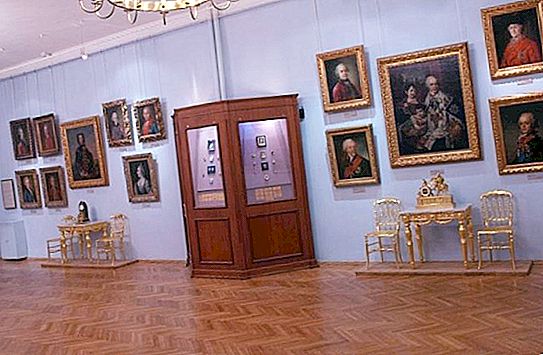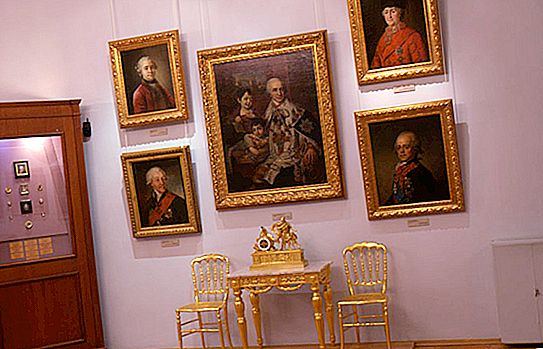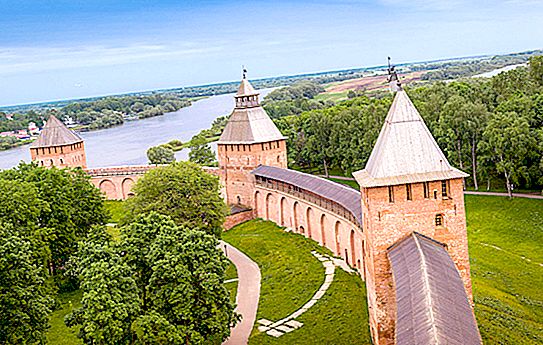The exact founding date of Veliky Novgorod was lost between the 8th and 9th centuries. Life here always flowed violently - it was the Novgorodians who invited the Rurikovichs to reign on the Slavic lands, the Novgorod freemen was formed on this territory, the foundations of Russian statehood were laid. Historical monuments and cultural heritage are preserved in the united museum-reserve of the city, part of which is the Museum of Fine Arts of Veliky Novgorod.
House of the Noble Assembly
Throughout the centuries of the city’s existence, talented and hardworking people have lived in it, having left a legacy of amazing architectural monuments, an original culture, a huge variety of crafts, characteristic only of Veliky Novgorod. The Museum of Fine Arts carefully preserves the rarities of antiquity and canvases by contemporary artists. Since 2005, the exposition has been deployed in the halls of the House of the Noble Assembly, which is an architectural monument of the 19th century.
The building of the Museum of Fine Arts adorns the southern part of Victory-Sophia Square. They thought about the need to build a house for assemblies of the local nobility since 1830, but for a long time they could not choose a worthy place, the submitted projects raised doubts. Consent was reached in 1850, the project was authored by Andrei Shtackenschneider, an architect from St. Petersburg.
At the beginning of construction, a significant event took place - digging a foundation pit for the foundation opened an ancient treasure, it contained rubles, bullion and half a cent of old coinage. The construction of the house was carried out under the guidance of the provincial architect Alexander Musselius. The rebuilt building divided the large Sofia Square into two parts, one of them became a trading one, called Sennaya.
"Balls, beauties, footmen, cadets …"
In addition to the meetings of the nobility, the house became the center of the social and cultural life of the city, it housed a library, offices of the county and provincial leaders of the nobility. Since 1843, a club of the local noble assembly received premises in the building. Balls were held, concerts and performances were given. In early December, a traditional, big ball was held, where the whole world of the province gathered.
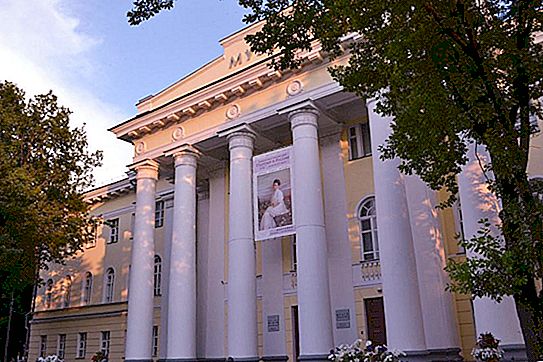
In the year of the millennium of Russian statehood, magnificent celebrations were organized in the house of the Noble Assembly, in which Emperor Alexander II and members of the ruling dynasty took part. In 1911, the walls of the house, throughout the summer, held meetings of the 15th All-Russian Congress of Archaeologists.
Whirlwinds of revolution
The new system, which came in 1917, had different ideas about the structure of society, titles and ranks were abolished, and the executive committee of the local Council of Workers and Peasants' Deputies was approved in the building. In 1919, with a large crowd of people, Leo Trotsky made a fiery speech here, which caused unusual excitement. In 1920, the hospital first housed the infirmary, and a little later, the House of Unions. By next year, the building received a new name - the Palace of Labor.
In 1923, a library with a reading room, a club for workers, an exhibition of achievements was organized in the halls, and a department of historical and political memoirs was organized, where lectures were given on the goals of trade union activity, the destructiveness of the bourgeois system, etc. The public actively participated in disputes on religious topics, examples were taken from their own lives, condemning local monks and monasteries. The club’s library was remarkable, the fund contained more than 40 thousand volumes of literature collected from private collections, donations, it also included books of the former Zemstvo library.
After the war
In wartime, the city fell into occupation, the building was badly damaged. The authorities were able to carry out a complete reconstruction in the 50s, while the appearance of the house changed significantly - the facade decor disappeared, the third floor appeared, and the entrance group was decorated with a classic portico with columns. Party functionaries began to receive education on the premises, studying at the Soviet-party school.
Since 1961, the building was transferred to the Leningrad Electrotechnical Institute, and after three years a branch of the university began to work. In 1973, the Polytechnic Institute of Novgorod was founded on its basis. Since the end of the 1980s, the building was closed for overhaul and reconstruction, after completion of work, since 2001, the Museum of Fine Arts of Veliky Novgorod was located in the halls.
Collection history
The main funds of the collection are collected from private collections of the noble estates devastated by the revolution, many paintings needed restoration, museum staff personally took part in preserving the heritage. Part of the collection was transferred to the Museum of Fine Arts of Veliky Novgorod from the Central Museum Fund of Petrograd, where paintings from the surrounding palaces were brought.
During the war, most of the collection died - was damaged, was lost. In the late 40s, canvases sent to the city returned to the city, but there were very few of them. Work began again on filling the funds, some of the works were purchased from private individuals, a lot was accepted as a gift.
Today the museum collection has more than 6 thousand units of storage. Before the start of the tour it is worth getting acquainted with the building, it is an architectural monument and is part of the Novgorod United Museum-Reserve. The address of the Museum of Fine Arts of Veliky Novgorod is Victory-Sofia Square, building 2.
Description
The Museum of Fine Arts has been operating in Novgorod since 2001. In the halls there are expositions “Russian art of the 18th-20th centuries” and “Art of Russia of 1917-2000”. A rich collection introduces the audience to the canvases of famous classics of the Russian school of painting, drawing, sculpture, the museum is especially proud of the collection of portrait miniatures in a wide variety of styles and genres. Most of this fund was acquired in 1979 from the famous Moscow collector of antiquities.
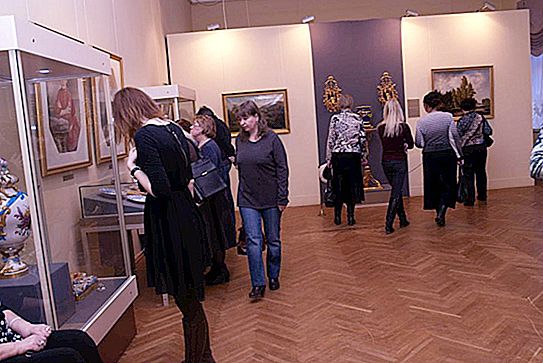
The collection of the Museum of Fine Arts represents the main paths of development of Russian art. Opens the exhibition canvas B. Villevalde "Opening of the monument to the millennium of Russia in Novgorod." The collection of the art gallery includes oil paintings, graphic works, watercolor sketches, sculptural compositions by famous Russian classics and local artists.
About the city and not only
The Novgorod theme was and remains a priority in collecting works of art for the museum funds. The collection already contains watercolors and paintings by restorers G. Shtendler, V. Chekhonadsky, L. Krasnorechiev, I. Kushnir and other masters of the architectural landscape. Pictures of this subject represent not only artistic, but also historical value for the city. On them you can trace the stages of development of the city, the changes taking place in it.
No less interesting are the works of other artists of this genre, in whose paintings Veliky Novgorod was reflected. The Museum of Fine Arts invites you to get acquainted with the landscapes of B. Yamanov, Yu. Eryshev, D. Zhuravlev, A. Varentsov and many other authors who have found inspiration in the nature of the Novgorod region.
Wealth
The pride of the exhibition dedicated to Russian artists are paintings by Bryullov, Shishkin, Repin, several paintings by Aivazovsky and several other eminent classics. An exposition of portraiture is exhibited in a separate room, the genre became popular in the 18th century. The historical value of this collection can hardly be overestimated; portraits of famous statesmen and courtiers who influenced the course of the state’s history are presented in it.
In the gallery you can see the ceremonial portraits of A. Orlov-Chesmensky, I. Kutuzov, A. Arakcheev, F. Osterman, A. Lansky and others. In the collection of the Novgorod Art Gallery there are several paintings by Bryullov, one of them is “Portrait of A. N. Strugovshchikov”. This painting is dedicated to one of the best translators of Goethe and Schiller, in the work of the artist the image of the writer found a halo of mystery and romanticism.
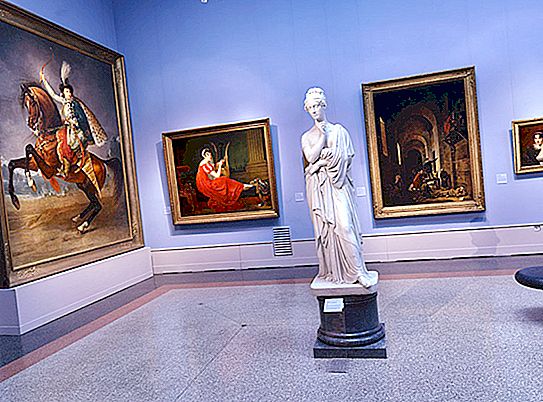
The graphics section attracts connoisseurs of works by famous masters such as I. Golitsyn, B. Kreutzer, E. Ivanov, V. Favorsky, S. Pustovoitov. The sculpture collection is no less interesting by the big names of talented architects. In the halls you can admire the skills of I. Ginsburg, T. Gavrilova, M. Manizer, the largest number of works presented in the exhibition belongs to the cutter N. Tomsky. In one of the halls of the museum there is a sculpture “Volkhov”, its author is one of the mysterious and talented representatives of Russian symbolism and modernism - Mikhail Vrubel.
All treasures are available for inspection at the Museum of Fine Arts of Veliky Novgorod. The work schedule is constant - the exhibition is open from 10:00 to 18:00 hours, except Monday (day off).
One touch
Cities with great historical memory and a preserved heritage were not able to be examined by anyone, but in a short visit you can plan routes for a more detailed sightseeing of Veliky Novgorod.
What to see in 1 day:
- Novgorod Kremlin, aka Detinets (entrance from Sophia Square). The first mention of a defensive structure was found in chronicles of the 11th century. The Kremlin is the cultural, political and social center of the Novgorod principality. Decrees and letters were sent from here, a national assembly was going to its square, the foundations of the state were laid. Today it is a cultural and historical center, where the Philharmonic, restoration workshops, St. Sophia Cathedral, Novgorod Museum-Reserve, and the Kokuy Tower are located.
- Sophia Cathedral. The five-domed church was built in the 11th century from wood; after the fire, a stone church was built. Prince Vladimir hid his treasures within the walls of the church, most of them went to Ivan the Terrible, but many believe that some of the treasures are still in safe vaults. On the adjacent territory lie the remains of Princess Anne, Prince Vladimir, many bishops, saints and princes. Since 1991, St. Sophia Cathedral became subordinate to the Orthodox Church.
- Museum-Reserve. Its permanent exhibition is deployed in the office building. The exhibition tells about the history of the region, historical milestones of development. Here is a rich collection of ancient Russian icons, a children's museum center.
- Kremlin park. Before the revolution, it was called the "Summer Garden", which housed 8 temples. Today it is a recreation area for citizens and many tourists. For the entertainment of children and adults, excellent conditions have been created - there are rides, a tennis court, a variety platform, boat rental, a cafe and a restaurant.
- Yaroslav's Courtyard (Nikolskaya St., Building 1). The road here leads from Detinets along the historic bridge. The courtyard is an old shopping center. There are several historical and architectural monuments - the Nikolo-Dvorishchensky Cathedral, six small churches, the unique architectural complex of the Trade side, the gate tower of the Gostiny Dvor, Hanseatic sign. The adjacent streets of tourists will be interested in several surviving mansions of the Novgorod merchants.
This list is a small part of the sights of Veliky Novgorod. What to see in 1 day, if you come a second time? There are a huge number of ancient temples and monasteries in the city and its environs, some have hundreds of years of history and many operate again. Also of interest is the Vitoslavlitsy Museum of Wooden Architecture, an architectural monument of Rurikovo ancient settlement, where many centuries ago there were princely chambers. It’s worth allotting more time for sightseeing, not limited to a fleeting acquaintance with a long history.
Reviews
Most tourists do not ignore the Museum of Fine Arts of Veliky Novgorod. The reviews left by visitors tell us that the exposition is very interesting and shines with the names of famous artists, which caused a pleasant surprise for many. Visitors felt that the originals of Aivazovsky, Shishkin, Bryullov, Vrubel and many other classics are a huge asset, rarely found outside of St. Petersburg or Moscow.
Large halls, two large expositions, a poster of temporary exhibitions and events speak in favor of the museum staff. Visitors note that you can learn a lot with the audio guide, which contains a large amount of information. The tour, accompanied by a specialist, of course, is more informative. It is quite simple to become a member of an organized group; the museum introduced the practice of combined excursions.

